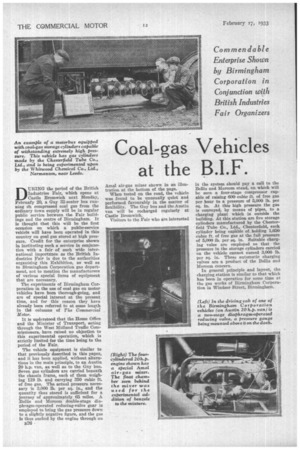Coal-gas Vehicles
Page 40

If you've noticed an error in this article please click here to report it so we can fix it.
at the B.I.F.
DURING the period of the British Industries Fair, which opens at Castle Bromwich next. Monday, Februafy 20, a Guy 32-seater bus running ob compressed coal gas from the ordinary town supply will be in regular public service between the Fair buildings and the centre of Birmingham. It is thought that this will be the first occasion on which a public-service
vehicle will have been operated in this country on goal gas stored at high pres sure. Credit for the enterprise shown In instituting such a service in conjunction with a fair of such wide inter national importance as the British In dustries Fair is due to the authorities organizing this Exhibition, as well as to Birmingham Corporation gas department, not to mention the manufacturers of various special items of equipment that are necessary.
The experiments of Birmingham Corporation in the use of coal gas on motor vehicles have been thorough-going, and are of special interest at the present time, and for this reason they have already been referred to at some length in the columns of The Cornntercial Motor.
It is understood that the Home Office and the -Minister of Transport, acting
through the West Midland Traffic Commissioners,. have raised no objection to this experimental operation, which is strictly limited for the time beingto the period of the Fair.
The vehicle equipment is similar to that previously described in this paper, and it has been applied, without altera tions in the main principle, to an Austin 20 h.p. van, as well as to the Guy bus.
Seven gas cylinders are carried beneath the chassis frame, each of them weighing 119 lb. and carrying 350 cubic ft.
of free gas. The actual pressure neces sary is 3,000 Ib per sq. in., and the quantity thus stored is sufficient for a journey of approximately 65 miles. A Bollis and Morcom double-stage diaphragm-operated reducing-valve gear is employed to bring the gas pressure down to a slightly negative figure, and the gas Is thus sucked by the engine through an B26 Amal air-gas mixer shown in an illustration at the bottom of the page.
When tested on the road, the vehicle was found to be unusually quiet and performed favourably in the matter of flexibility. The Guy bus and the Austin van will be recharged regularly at Castle Bromwich.
Visitors to the Fair who are interested
in the system should pay a call to the Bellis and Hloreom stand, on which will be seen a four-stage compressor capable of raising 600 cubic ft. of free gas per hour to a pressure of 5,000 lb. per sq. in. At this high pressure the gas is conveyed, by means of pipes, to a charging plant which is outside the building. At this station are five storage cylinders manufactured by the Chesterfield Tube Co., Ltd., Chesterfield, each cylinder being cap-able of holding 1,650 cubic ft. of free gas at the full pressure of 5,000 lb. per sq. in. Suitable charging vales are employed so that the pressure in the storage cylinders carried on the vehicle cannot exceed 3,000 lb. per sq. in. These automatic charging valves are a product of the Denis and Alorcoth concern.
In general principle and layout, the charging station is similar to that which has been in operation for some time at the gas works of Birmingham Corporation in Windsor Street,. Birmingham.




























































































